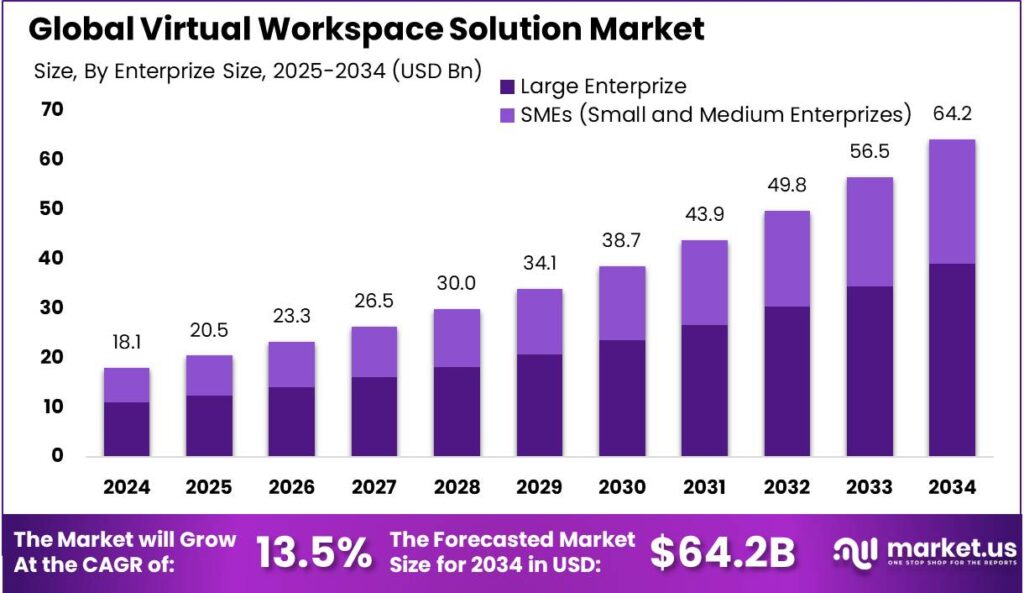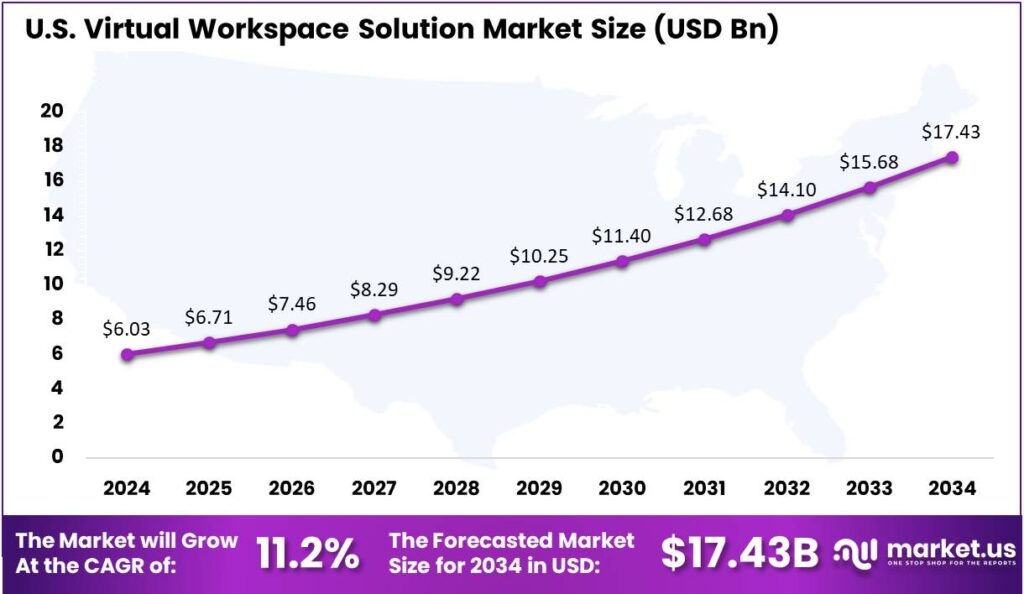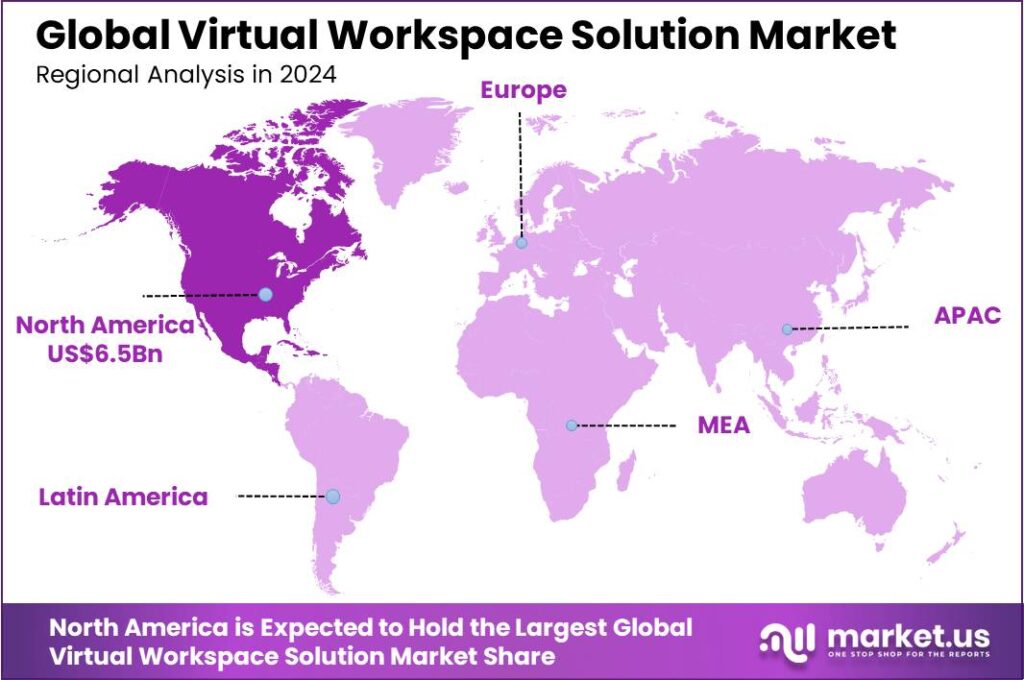Table of Contents
Report Overview
The Global Virtual Workspace Solution Market is projected to soar to an estimated USD 64.2 billion by 2034, up from USD 18.09 billion in 2024, with a robust compound annual growth rate (CAGR) of 13.5% from 2025 to 2034. North America is expected to lead the charge in this growth, commanding over 36% of the market share and generating a revenue of $6.5 billion by 2024. Within this region, the U.S. market alone is set to hit $6.03 billion, reflecting a strong CAGR of 11.2%.
Virtual workspace solutions are becoming increasingly popular in today’s business landscape, enabling remote and hybrid work by integrating digital tools for collaboration and communication. These platforms centralize data and applications, improving accessibility, operational efficiency, and productivity.
Several factors are driving the growth of virtual workspace solutions. The shift to remote work, accelerated by the COVID-19 pandemic, has made these platforms essential for maintaining business continuity and supporting remote teams. Additionally, the integration of AI and machine learning has enhanced the functionality and scalability of these solutions, making them more attractive to businesses aiming to streamline workflows.
The virtual workspace sector is witnessing several emerging trends. One significant trend is the increased use of artificial intelligence to personalize user experiences and streamline work processes. AI-driven analytics are being used to monitor productivity and wellness, helping managers support their teams more effectively. Additionally, there is a growing emphasis on security enhancements, as the rise in remote work has also increased vulnerabilities to data breaches and cyber threats.

As businesses around the world continue to embrace flexible work arrangements, the market for virtual workspace solutions is expanding significantly. This expansion is not limited to tech companies or specific industries but is widespread across various sectors including education, healthcare, and government. The adaptability of virtual workspaces to various business needs and their ability to support a global workforce are key drivers behind their increased adoption.
Key Takeaways
- The U.S. virtual workspace solution market is projected to reach $6.03 billion by 2024, with a solid CAGR of 11.2%.
- North America is expected to dominate, holding over 36% of the global market share and generating $6.5 billion in revenue by 2024.
- The Cloud-based segment will capture more than 74% of the market share in the Virtual Workspace Solution (VWS) space by 2024.
- The Virtual Desktop Infrastructure (VDI) segment is anticipated to lead with over 45% of the market share in 2024.
- Large Enterprises are projected to account for more than 61% of the market share in the virtual workspace solution sector by 2024.
- The IT & Telecom sector will hold a dominant position, with over 30% of the total market share in 2024.
Impact Of AI
- Enhanced Collaboration and Communication: AI technologies like natural language processing enhance communication by providing real-time language translation and sentiment analysis, which helps in clearer and more inclusive team interactions. AI-powered tools also handle routine inquiries, allowing employees to focus on more complex tasks.
- Intelligent Automation: AI is streamlining remote work by automating routine tasks such as scheduling and data analysis, thereby enhancing productivity. This automation allows employees to concentrate on higher-value activities.
- Personalized Digital Environments: AI-driven systems are increasingly capable of analyzing individual work patterns to create customized user experiences that enhance productivity by recommending tailored workflows and resources.
- Advanced Security Measures: In the virtual workspace, AI improves security by detecting anomalies and potential threats in real-time, which helps protect sensitive information from breaches.
- Remote Work Optimization: AI optimizes remote work scenarios by managing logistics like time zones and team coordination, which supports the growing trend towards hybrid work environments.
U.S. Market Size
The market for virtual workspace solutions in the United States is projected to achieve significant growth, reaching a valuation of $6.03 billion by the year 2024. This expansion represents a robust compound annual growth rate (CAGR) of 11.2%. The growth is driven by several key factors that influence market dynamics, including increasing demand for remote working capabilities and advanced technological integration in business processes.
Take advantage of our unbeatable offer - buy now!

Organizations across various sectors are increasingly adopting virtual workspace solutions to enhance flexibility and efficiency, thus fueling market expansion. These solutions offer the benefits of remote access to resources, reduced operational costs, and improved collaboration among geographically dispersed teams. Moreover, as cybersecurity measures strengthen and connectivity improves, businesses are more confident in deploying virtual workspaces extensively.
Ongoing innovations in cloud technology and AI are driving the development of advanced virtual workspace platforms. These platforms offer seamless, secure experiences and enhanced customization, making them essential for companies seeking to stay competitive in a fast-evolving digital landscape.

In 2024, the virtual workspace solution market saw North America emerge as a dominant force, securing over 36% of the global market share. This substantial portion translated to an estimated revenue generation of USD 6.5 billion. North America’s leading position is driven by advanced technological infrastructure and strong demand for innovative remote working solutions among businesses.
The tech-savvy workforce and early adoption of cloud-based technologies have fueled the growth of virtual workspace solutions in North America. Companies in the U.S. and Canada are using these solutions to improve efficiency and support flexible work environments. This shift is driven by the need to accommodate remote work and integrate various systems into seamless, user-friendly platforms.
Government support and favorable policies have significantly contributed to the dominance of the virtual workspace market in North America. Initiatives promoting internet accessibility and digital tools in businesses have accelerated adoption. As companies prioritize digital readiness, the market is expected to continue growing, driven by technological advancements and a shift toward scalable work environments.

Market Segmentation
By Deployment
- Cloud-based
- On-premises
By Solution Type
- Virtual Desktop Infrastructure (VDI)
- Desktop-as-a-Service (DaaS)
- Virtual Private Network (VPN)
By Enterprize Size
- Large Enterprize
- SMEs (Small and Medium Enterprizes)
By End-User Industry
- IT & Telecom
- Healthcare
- BFSI (Banking, Financial Services & Insurance)
- Education
- Manufacturing
- Others (Governmen, Retail, etc.)
Emerging Trends
A key trend is the merging of endpoint security, employee experience, and device management. By unifying these areas, companies can enhance security without disrupting workflows, boost employee satisfaction through smoother device performance, and streamline management processes. This holistic approach ensures that security measures support rather than hinder daily tasks, leading to a more efficient and satisfying work environment.
Another significant development is the renewed interest in private cloud solutions. Many organizations are moving workloads back to private clouds to gain better control over sensitive data, ensure compliance with industry regulations, and optimize performance for specific applications. This shift allows businesses to tailor their cloud environments to meet unique needs, offering a balance between security and efficiency.
Top Use Cases
Virtual workspace solutions have become essential for modern businesses, offering several key benefits. They enable seamless communication through tools like video conferencing, instant messaging, and virtual whiteboards, allowing team members to interact in real-time, regardless of their location. This fosters effective collaboration, ensuring projects progress smoothly even when team members are miles apart.
Additionally, virtual workspaces provide secure cloud storage for data, ensuring that important files are accessible to authorized personnel from anywhere. They also support the use of personal devices, allowing employees to work on their own laptops or tablets while maintaining security and control over corporate data. This flexibility not only enhances productivity but also reduces hardware costs for organizations.
Major Challenges
Virtual workspaces, while essential, bring several challenges. Communication barriers can lead to misunderstandings without face-to-face interaction, and building trust within teams becomes harder. The lack of a shared office culture makes fostering a sense of belonging and team cohesion more difficult. Additionally, distractions at home can impact productivity, as interruptions in the home environment are not present in a traditional office setting.
Security is a key concern in virtual workspaces, as maintaining proper data protection protocols is crucial to safeguard sensitive information. The reliance on technology also means that technical issues can disrupt workflow, highlighting the need for reliable IT support. Additionally, the lack of social interactions can lead to feelings of isolation, affecting employees’ well-being and job satisfaction.
Market Opportunities for Key Players
- Remote and Hybrid Work Models: The shift towards remote and hybrid work arrangements has created a substantial demand for virtual workspace solutions. Organizations are seeking flexible, secure, and efficient platforms to support their distributed teams. This trend is expected to continue, offering opportunities for companies to develop and provide solutions that cater to this evolving work environment.
- Integration of Advanced Technologies: Incorporating advanced technologies such as artificial intelligence (AI), machine learning (ML), and virtual reality (VR) into virtual workspace solutions can enhance user experience and productivity. For instance, AI can automate routine tasks, while VR can facilitate immersive collaboration. Companies that integrate these technologies into their offerings can differentiate themselves in a competitive market.
- Cloud-Based Solutions: The increasing adoption of cloud computing presents a significant opportunity for virtual workspace solution providers. Cloud-based platforms offer scalability, flexibility, and cost-effectiveness, making them attractive to businesses of all sizes. Developing robust and secure cloud-based solutions can meet the growing demand for accessible and efficient virtual workspaces.
- Industry-Specific Solutions: Tailoring virtual workspace solutions to meet the unique needs of specific industries such as healthcare, education, and finance can open new market segments. These sectors often require specialized features and compliance with strict regulations, presenting opportunities for companies to develop customized solutions that address these specific requirements.
- Global Expansion: Expanding into emerging markets, particularly in Asia Pacific, offers significant growth potential. The region is experiencing rapid digital transformation, with increasing adoption of remote work and cloud technologies. Companies that establish a presence in these markets can tap into a growing customer base seeking virtual workspace solutions.
Competitive Landscape
- Hive Workspaces
- Tixio.io
- Slack
- Zoom
- Kumospace
- SpatialChat
- Teamflow
- Happeo
- TimeCamp Planner
- Tandem
- Sococo
- NexGen Virtual Office
- Bit.ai
- Wurkr
- Pragli
- Bluescape
- Filo
- Other Key Players
Recent Developments
In November 2024, Citrix, a division of Cloud Software Group, Inc., unveiled the general availability of Citrix DaaS for Amazon WorkSpaces Core. This exciting new integration combines Citrix’s powerful Desktop as a Service (DaaS) with AWS’s virtual desktop infrastructure (VDI) platform, Amazon WorkSpaces Core, offering enhanced capabilities for cloud-based desktop solutions.
Report Scope
| Report Features | Description |
| Market Value (2024) | USD 18.09 Bn |
| Forecast Revenue (2034) | USD 64.2 Bn |
| CAGR (2025-2034) | 13.50% |
| Base Year for Estimation | 2024 |
| Historic Period | 2020-2023 |
| Forecast Period | 2025-2034 |
Conclusion
In summary, the Virtual Workspace Solution market is experiencing significant growth driven by the increasing demand for remote work, flexibility, and digital transformation across various industries. Companies are increasingly adopting virtual workspace solutions to streamline collaboration, enhance productivity, and maintain business continuity. The integration of cloud computing, artificial intelligence, and advanced security measures further accelerates the adoption of these solutions, enabling businesses to deliver seamless, scalable, and secure work environments for their employees.
As the market continues to expand, organizations must focus on selecting the right tools that offer optimal customization, user experience, and support to stay ahead of the competition. In the future, virtual workspace solutions are expected to evolve with innovations such as virtual reality and augmented reality, creating more immersive and interactive workspaces. The ongoing shift toward hybrid work models is poised to further fuel the demand, making these solutions an essential part of modern business operations.
Discuss your needs with our analyst
Please share your requirements with more details so our analyst can check if they can solve your problem(s)



